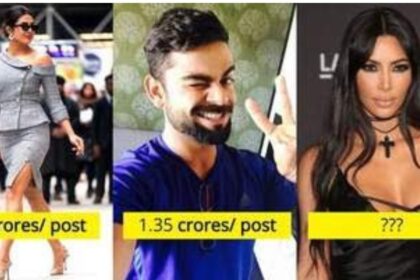
Over the last two decades, social media has become an integral part of people’s lives—and a crucial way for brands to reach new audiences. As more users joined social media platforms like Facebook, YouTube, Instagram, Pinterest, Snap chat, and Twitter, and the time spend by each of us increases many of them became content creators themselves, curating and crafting their own stories, photos, and videos for others to see.
This is how social media influencers were born, and quickly attracted the attention of marketers. Over the last five years, brands have collaborated with social media influencers across channels to generate awareness, and influencer marketing grew from an ancillary marketing tactic to a $5-10 billion-dollar industry.
Consider these facts
1. Priyanka Chopra earns Rs 1.87 crore per post in Instagram
2 Virat Kohli earns about Rs 1.35 crore per post
3. There are more than 1200 creator channels in You tube in India with more than 1 million subscribers up from 16 channels in 2014
4. A nano influencer with about 5000 followers earns up to Rs 7000 per post
5. A micro influencer with about 30000 followers earns up to Rs 18,000 per post
6. Influencers with close to 5 lac followers earn close to Rs 7 lacs per post
So what is Influencer Marketing?
A social media influencer is someone who has built a loyal following through their online content creation. Influencer marketing is when companies partner with influencers in order to increase brand awareness or conversions among a specific target audience.
Marketers accomplish this through sponsoring an influencer’s online content, with the goal of endorsing their brand, product or service, and in some cases, drive purchases.
And What Makes a Quality Influencer?
Here are the top 5 things marketers look for when deciding the best influencers to work with:
1. Quality of content.
2. Target audience.
3. Engagement rate.
4. On-brand messaging.
5. Budget.
Engagement is by far the most common metric used for measuring influencer marketing success, measured by 75% of marketers for influencer marketing.
The engagement rate of a post is calculated by adding up engagement (likes, comments, etc.) and dividing it by the influencer’s total number of followers.
Note that engagement rates for sponsored content will almost always be lower than on organic posts.
Here are the Top five influencer marketing goals cited by marketers:
1. Increase brand awareness.
The most popular goal for influencer marketing campaigns is building awareness around a brand, product or service. Brand awareness is generally measured through impressions, reach and engagement metrics.
2. Reach new audiences.
Influencers should be able to share their audience data (age, gender, location, interests, etc.) to help ensure alignment with your target audience.
3. Generate sales.
More influencer campaigns today are aimed at driving tangible sales, which can be clearly tracked using custom links, landing pages and redemption codes.
4. Improve brand advocacy.
Influencers are expected to provide strong validation and spark word-of-mouth conversations about your product or brand among their fans.
5. Drive lead generation.
Aside from sales, new leads are another popular direct response metric for influencer marketing campaigns. Names and emails can be collected through newsletter subscriptions, account setups, or giveaway entries.
But what are the biggest Challenges faced in Influencer Marketing?
1. Spotting fake followers and inauthentic engagement.
Although Instagram has cracked down on third party services that peddle in fake followers and inauthentic engagement, it appears that marketers remain skeptical about the scope or effectiveness of this ban.
2. Social algorithms making content less visible.
Social media platforms have changed the algorithms of their users’ feeds since the social feed was created—but in recent years algorithm changes have stirred up influencer communities.
For example, in September 2018 YouTube came under fire for their algorithm changes supposedly leading to creator burnout, as influencers raced to produce more content so their videos wouldn’t drop from the feed.
3. Building an always-on strategy, rather than one-off campaigns.
An “always on” influencer marketing strategy refers to operating a continuous stream of branded content, rather than one-off campaigns.
4. The rising costs of influencers.
For example, Kylie Jenner charges a whopping $1 million per sponsored Instagram post. However on the other end of the spectrum, marketers are exploring partnering with smaller, more accessible influencers such as nano influencers, who will often work for a nominal fee or in exchange for a free product.
Below are some of the key trends which are further shaping up this channel
1. Instagram ranks #1 for the most important and impactful channel.
With over 1 billion users and a fast-growing network of influencers churning out millions of sponsored posts each year, Instagram has become the most important influencer marketing channel.The ease of photo-sharing on Instagram spawned a huge variety of influencers with a direct line to different niche audiences.
2. Over ⅔ of marketers will spend the most on Instagram.
Data suggests that Instagram will also attract a lot more marketing spend in 2019. 69% of marketers plan to spend the most money on Instagram for influencer marketing this year. That’s over six times more than YouTube (11%), the second most-selected channel for top spend.
3. Instagram posts are the most used format of influencer marketing.
When asked to pick the content formats they find effective for influencer marketing, 78% of marketers chose Instagram posts—the #1 choice.
Compared to videos or longer-form content, a single photo and caption requires relatively less production cost and effort, making it a more affordable option for small companies looking to test Instagram influencer marketing.
4. Instagram stories are the second most used format, followed by YouTube videos and Instagram videos.
Instagram Stories rank as the second most popular content format for influencer marketing, after Instagram posts. Stories originally gained popularity with Snap chat, and today over 500 million Instagram users use Stories every day.
Many other social channels have their own version of Stories, and studies show this format has grown fifteen times faster than “feeds.” Users respond positively to Stories because they perceive this impromptu swipe-able montage series to be less staged, more authentic, and easier to navigate.
Video formats are also popular, with YouTube videos and Instagram video ranking high on the list of effective formats for influencer marketing.
5. Ad spend, specifically in location-based marketing, is set to grow to $24.4 billion.
The projection of 14% growth in location-based marketing indicates an increased interest in this form of advertising. Marketers’ willingness to purchase location-based ads may suggest that this type of ad has proven a positive ROI in the past few years to many marketers.
6. Nearly half (43%) of advertisers plan to increase spending on influencer marketing.
7. Social referral traffic has become a major driver for retail e commerce sites (and continues to rise).
Social referral to retail sites has grown by 110% over the past two years. It’s growing faster than any other referral source. Facebook, being the leading social platform, drives the most traffic. Instagram and Pinterest are the most natural and relevant platforms for retailers to advertise on. Snapchat and Twitter also play a significant part in the ad game, but not as much as the other three.
8. TikTok’s worldwide in-app sales surged 500% in May from a year earlier.
TikTok, being the new kid on the block, is working hard to get the attention of advertisers. The app reached $9 million in-app sales in May and is forecast to reach $100 million
9. The Rise of the Nano-Influencer
Nano-influencers are people who haven’t quite established his or her brand but are on their way toward building a loyal community of followers through their social media. Nano-influencers are categorized as those who have less than 10,000 social media followers. Typically, their following is much smaller, at around 1,000 people, but those 1,000 followers are intensely dedicated to and engaged with the influencer.
But why, then, is the nano-influencer on the rise?
Simply put: because they’re cheaper and more willing to engage with their audience.
Influencer rates have skyrocketed in 2019 and brands have taken notice. Rather than work with one macro-influencer, brands are now seeking relationships with the lower tier of more niche influencers with smaller followings. Brands are able to create valuable partnerships with multiple nano-influencers for the same price as one macro-influencer, and also have had some success establishing gifting campaigns.
In a gifting campaign, a brand exchanges posts for products. Essentially, your company would send the nano-influencer some samples of your product and in return, he or she will post positively about the items you send them. These products will be relevant to their niche following, with the goal of influencing said followers to purchase your product or service.
10. Amazon Influencer Program
This program allows influencers to get rewarded for recommending their favorite products that are available on Amazon. Through the program, influencers can create their own Amazon page with a custom URL and use it to store all of their favorite products in one place.
The influencer can then share the custom URL to his or her followers and encourage their audience to check out the products. When a follower makes a purchase through the influencer’s custom storefront, the influencer will earn a small commission on qualifying purchases.
11. Affiliate Marketing
Brands can also incentivize influencers to drive sales by offering a percentage commission on each transaction the influencer helps to close. This is a practice that’s known as affiliate marketing.
Marketers are in agreement that ROI from influencer marketing is comparable to or better than other marketing channels and is one of the prime reasons for the increase in spend on this channel.
To conclude, it is clear that social influencers are on the rise and are growing to mighty power houses who use their massive followings to build brand relationships, sway purchase decisions, and bring in earnings to match the lavish lifestyles their profiles would suggest.
They wield a tremendous amount of power in the digital space, and when the right relationships are leveraged properly, they can offer a much-needed boost to any company’s sales and brand visibility



